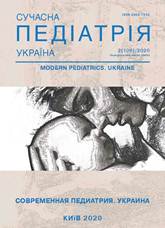Auditory function in children with adenoid vegetations
Keywords:
adenoid vegetation, hearing, otitis media, treatment, childrenAbstract
When hypertrophied lymphoid tissue is spread to the auditory tube, there is a decrease in ventilation of the tympanic cavity, which further leads to a decrease in hearing and the development of secretory otitis media.
The purpose of the study was to investigate hearing in children with adenoid vegetations and evaluate the effectiveness of adenotomy in secretory otitis.
Material and methods. Under our observation, the clinic had 239 children with adenoid vegetations of grade II–III ranging in age from 2 to 15 years. Hypertrophy of the palatine tonsils of the II–III degree occurred in 92 (38.5%), chronic tonsillitis — in 42 (17.6%) patients. Children with suspected hearing loss were either audiometric or impedansometric for hearing, depending on age. All children underwent endotracheal anesthesia under endoscopic control.
Results. An impedance test was performed in 101 patients. Tympanograms of type «A» had 20 people (19.8% of cases), «C» — 25 people (24.8% of cases), «B» — 56 people (55.4%). After adenotomy according to the proposed method, hearing was restored or improved in all patients with secretory otitis. Only 12 children were registered with type C tympanograms, which indicates high efficiency of surgical treatment. In the C group, tympanograms after treatment were observed in 8 (4%) patients and in the comparison group in 6 (8.2%) patients.
Conclusions. According to acoustic impedanceometry, 81 (33.9%) patients with adenoid vegetations revealed changes in the auditory analyzer system characteristic of secretory otitis media. Impedanceometry results should be considered as an additional criterion in determining the indications for adenotomy in children.
The research was carried out in accordance with the principles of the Helsinki Declaration. The study protocol was approved by the Local Ethics Committee of an participating institution. The informed consent of the patient was obtained for conducting the studies.
No conflict of interest was declared by the author.
References
Bezshapochnyiy SB, Gasyuk YuA, Smeyanov EV. (2017). Giperplaziya i vospalenie glotochnoy mindalinyi. Kiev: Logos.
Kosakivska IA. (2016). Pharyngeal tonsil hypertrophy, choanal polyps simulates. Sovremennaya Pediatriya.5(77): 137–138. https://doi.org/10.15574/SP.2016.77.137
Kosakivska IA. (2018). Experience in the implementation of adenotomy in children Sovremennaya Pediatriya.8(96): 37–41. https://doi.org/10.15574/SP.2018.96.37
Kosakivska IA. (2018). Diagnostics difficulties of adenoid vegetations in children. Sovremennaya Pediatriya. 5(93): 11–13. https://doi.org/10.15574/SP.2018.93.11
Laiko AA, Zabolotnyi DI, Melnykov OF et al. (2010). Adenoidyt. Kyiv: Lohos.
Laiko AA, Kosakovskyi AL, Zabolotna DD et al. (2013). Dytiacha otorynolarynholohiia: Natsionalnyi pidruchnyk. Za red. Laika AA. Kyiv: Lohos.
Patent Ukrainy na korysnu model No. 114693. MPK (2006.01) A61V18/04, A61V18/14. Prystrii dlia koahuliatsii. I.A. Kosakivska (Ukraina). Zaiavleno 26.10.2016; Opubl. 10.03.2017 r. Biul. No.5.
Jerger JF, Antony I, Jerger S, Grump B. (1973). Studies in impedance audiometry. Arch Otolaryngol.99: 165–171. https://doi.org/10.1001/archotol.1974.00780030173003; PMid:4854446
Downloads
Published
Issue
Section
License
The policy of the Journal “MODERN PEDIATRICS. UKRAINE” is compatible with the vast majority of funders' of open access and self-archiving policies. The journal provides immediate open access route being convinced that everyone – not only scientists - can benefit from research results, and publishes articles exclusively under open access distribution, with a Creative Commons Attribution-Noncommercial 4.0 international license (СС BY-NC).
Authors transfer the copyright to the Journal “MODERN PEDIATRICS. UKRAINE” when the manuscript is accepted for publication. Authors declare that this manuscript has not been published nor is under simultaneous consideration for publication elsewhere. After publication, the articles become freely available on-line to the public.
Readers have the right to use, distribute, and reproduce articles in any medium, provided the articles and the journal are properly cited.
The use of published materials for commercial purposes is strongly prohibited.

